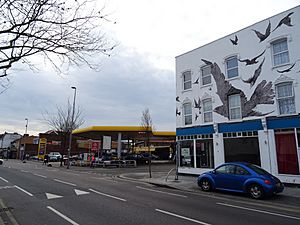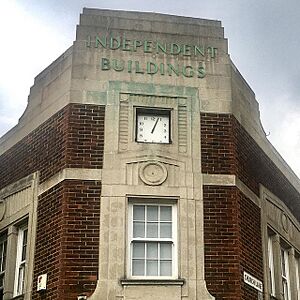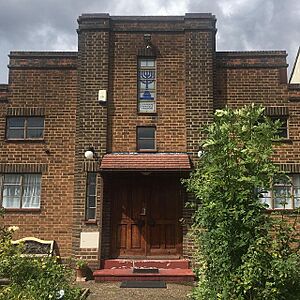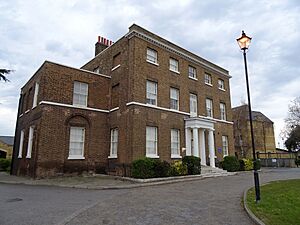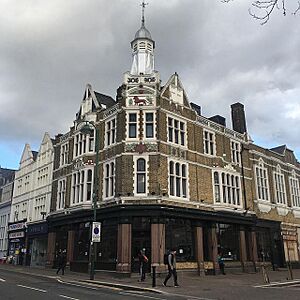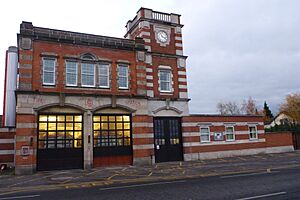Leytonstone facts for kids
Quick facts for kids Leytonstone |
|
|---|---|
 Leytonstone High Road |
|
| Population | 54,696 (wards, 2011) |
| OS grid reference | TQ3987 |
| London borough | |
| Ceremonial county | Greater London |
| Region | |
| Country | England |
| Sovereign state | United Kingdom |
| Post town | LONDON |
| Postcode district | E11 |
| Dialling code | 020 |
| Police | Metropolitan |
| Fire | London |
| Ambulance | London |
| EU Parliament | London |
| UK Parliament |
|
| London Assembly |
|
Leytonstone (pronounced LAY-ton-stone) is a lively area in East London, England. It's part of the London Borough of Waltham Forest. Leytonstone is about 7 kilometres (4.3 miles) north-east of Charing Cross, a famous spot in central London. It borders other areas like Wanstead, Forest Gate, Stratford, Leyton, and Walthamstow.
Historically, Leytonstone was a small part of Leyton in Essex. People first wrote about it in the 1300s, calling it 'Leyton-atte-stone'. This name came from a Roman milestone found here, which marked the edge of the parish. For a long time, Leytonstone was mostly countryside. But in the 1800s, things changed a lot. The railway station opened in 1856, making it easy to travel to London. This helped Leytonstone grow into a busy dormitory town where people lived and commuted to work. In 1965, when Greater London was formed, Leytonstone became part of the London Borough of Waltham Forest.
Leytonstone is also famous as the birthplace of the well-known film director Alfred Hitchcock. You can find many tributes to him around the area, including special murals, mosaics, a pub, and even a hotel!
Contents
- What is the History of Leytonstone?
- What Are the Areas of Leytonstone?
- What Notable Events Have Happened in Leytonstone?
- What Are Leytonstone's Famous Buildings and Landmarks?
- How is Leytonstone Governed?
- How Can You Travel in Leytonstone?
- What Schools Are in Leytonstone?
- What Sports and Fitness Activities Are Available?
- Who Are Some Famous People from Leytonstone?
- Images for kids
- See also
What is the History of Leytonstone?
How Did Leytonstone Get Its Name?
The main road in Leytonstone, called Leytonstone High Road, is actually part of a very old road that connected Epping to London. It runs along the edge of Epping Forest. Leytonstone started as a small village in the early 1300s. It was part of the larger area of Leyton.
The name Leytonstone comes from two parts: "Leyton" means a "settlement on the River Lea," and "stone" refers to a special Roman milestone. This stone was known as the High Stone.
The Ancient High Stone Landmark
The High Stone still stands today where Hollybush Hill and New Wanstead roads meet. It's an 18th-century obelisk built on an older stone base. People believe this older base was a Roman milestone. It might have marked an extension of a Roman road that went from Great Dunmow to Chigwell and into London.
You can still read some of the words on the obelisk, even though they are old. They say things like:
- "To Epping XI Miles through Woodford, Loughton"
- "To Ongar XV Miles through Woodford Bridge, Chigwell, Abridge"
Other Roman discoveries have been made nearby in Leyton. These include a Roman cemetery and large foundations of a Roman building.
How Did Leytonstone Grow in the 1800s?
In 1722, the writer Daniel Defoe visited Leytonstone. He described it as a place known by the sign of "The Green Man." Defoe thought Leytonstone, along with other nearby villages, was a great place for rich merchants and bankers to live. It was close enough to the City for an easy horse ride.
Leytonstone stayed mostly rural until the railway station opened in 1856. The railway made it quick and easy to get to Stratford and central London. This, along with more jobs becoming available, turned Leytonstone into a dormitory town by the late 1800s. A dormitory town is where people live and travel to another place for work.
However, the forest land in the north and east of Leytonstone was saved from being built on. This happened after a long public campaign. The Epping Forest Act of 1878 protected over 80 hectares (200 acres) of open space for everyone to enjoy.
In 1898, a department store called Bearmans opened in Leytonstone. It sold furniture and clothes. This store was special because it was the first outside central London to have an escalator!
What Happened in Leytonstone in the 1900s?
In the mid-1990s, a new road called the A12 (also known as the M11 link road) was built through Leytonstone. This project faced a lot of protest from local people and road protestors. These protests, and others like them, eventually led to the government changing its policy on building new roads.
What Are the Areas of Leytonstone?
Leytonstone has several distinct areas:
- Bushwood and Ferndale
- Browning Road Conservation Area
- Cann Hall
- Cathall
- Grove Green
- Harrow Green
- Upper Leytonstone
- Wanstead Flats
- Whipps Cross and Hollow Pond
Historic Areas
- Holloway Down
What Notable Events Have Happened in Leytonstone?
- The M11 Link Road Protest took place between 1993 and 1995.
- The first annual Leytonstone Festival was held in 1995.
- Special mosaics showing scenes from his movies were put up at Leytonstone tube station in May 2001.
- The Leytonstone Arts Trail is an annual art festival that started in 2008. During this event, local people and artists display their art in windows and local places.
- The annual Leytonstone Loves Film event, in partnership with The Barbican, began in 2019.
What Are Leytonstone's Famous Buildings and Landmarks?
Leytonstone has many interesting buildings and landmarks:
- The Green Man is a famous roundabout and pub at the north edge of Leytonstone. It has a statue and a mosaic, and it's still an important landmark for directions on the A12 road.
- Leytonstone is the birthplace of Sir Alfred Hitchcock, the famous film director. The entrance to Leytonstone tube station has mosaics that show scenes from his films. At 517 Leytonstone High Road, where he was born, the building has a mural of birds painted on it. A pub at 692 Leytonstone High Road was even renamed The Birds, after his movie The Birds.
- Leytonstone tube station is a post-war modernist building from 1947. It was designed by Thomas Bilbow for London Transport.
- The Independent Buildings on Church Lane are an art deco building with a clock, built in 1934. The nearby Seascape House has a similar architectural style.
- St John the Baptist's Church, Leytonstone is a Grade II listed church. Built in 1832, it's a landmark at the junction of High Road Leytonstone and Church Lane. The churchyard hosts a vintage market and sometimes shows Alfred Hitchcock films during the Leytonstone Festival.
- St Andrew's Church, Leytonstone, also Grade II listed, was built between 1886 and 1893. It was a memorial to the local helper William Cotton.
- The Leytonstone and Wanstead Synagogue is a post-war art deco building from 1954. It was built by the local Jewish community.
- Leytonstone Mosque is a 1970s building that was once a church hall. It provides a place of worship for up to 1000 male Sunni Muslims and offers religious education for young boys.
- Leytonstone House, built in 1800, is a Grade II-listed building. It was once the home of Sir Edward Buxton, an MP and conservationist. He helped save parts of Epping, Hainault, and Hatfield forests.
- Leytonstone Library is a Grade II* listed art deco building from 1934. It had a big refurbishment in 2015.
- Harrow Green Library is another art deco building that opened in 1939. It closed in 2011 due to funding cuts but is now run by volunteers as The Junction.
- The Leytonstone War Memorial and Gardens were unveiled in 1925. They remember people from Leyton and Leytonstone who fought in The Great War and World War II.
- The Red Lion pub has been on its site since 1670. The current building is from 1891 and has been restored as a craft beer pub, ballroom, and hotel.
- Whipps Cross University Hospital is being redeveloped to include a brand-new hospital, homes, and other facilities.
- Leytonstone Fire Station on Leytonstone High Road was a Victorian building. It was replaced by the current building in February 2016.
- Pastures and Good Shepherd Building in Davies Lane include a 17th-century house and a former Children's Home. It is now a Youth Centre and Sports Hall.
- Epping Forest reaches Leytonstone in areas like Hollow Pond, Leyton Flats, and Wanstead Flats. These are great places for outdoor activities.
How is Leytonstone Governed?
Leytonstone was originally part of the ancient parish of Leyton in Essex. It became its own church parish in 1845. In 1894, it became part of Leyton Urban District, which later became the Municipal Borough of Leyton in 1926.
In 1965, when Greater London was created, Leytonstone became part of the London Borough of Waltham Forest. Within this borough, Leytonstone is divided into four council wards. Each ward has three councillors who represent the local people.
Leytonstone is also part of the Leyton and Wanstead parliamentary constituency. This means it has a Member of Parliament (MP) who represents the area in the UK Parliament. As of July 2024, Calvin Bailey is the MP for this area, representing the Labour Party.
| Ward | Population | % Change 2001-19 |
|---|---|---|
| Cann Hall | 14,427 | +27% |
| Cathall | 13,112 | +24% |
| Forest | 13,196 | +27% |
| Leytonstone | 13,961 | +31% |
| Total | 54,696 | +27% |
How Can You Travel in Leytonstone?
Leytonstone tube station is in Travelcard Zones 3 and 4. It's on the Central line of the London Underground. This station is the last stop before the line splits into two branches: one goes towards Fairlop Loop and the other to Epping. Since 2016, Night Tube trains run on Fridays and Saturdays on the Central line. They run every 10 minutes between White City and Loughton or Hainault, passing through Leytonstone. The station's entrance passages are decorated with tiled mosaics that celebrate the local film director Alfred Hitchcock.
Leytonstone Bus Station is located near the tube station exits. Important bus routes include the 257 to Stratford and the W15 to Hackney. There's also a night bus, the N8, that goes to Tottenham Court Road.
Leytonstone High Road railway station is a London Overground railway station in the south of Leytonstone. It serves the Gospel Oak to Barking line. In 2018, the line was updated to allow for longer trains, which started running in June 2019.
Close to the southern end of Leytonstone is Maryland railway station in Stratford. This station is on the Elizabeth line.
Since October 25, 2021, Leytonstone has been part of London's Ultra Low Emission Zone (ULEZ). This zone aims to reduce air pollution by charging older, more polluting vehicles.
What Schools Are in Leytonstone?
Leytonstone has several schools for different age groups:
- Buxton School is an all-through school for ages 3–16. It is also a Specialist Science College.
- Connaught School for Girls is a specialist language school for girls.
- Davies Lane Primary School first opened in 1901. It became a junior and infants school in 1948 and a single primary school in 2004.
- George Tomlinson Primary School
- Gwyn Jones Primary School
- Leytonstone School is a specialist business and enterprise school.
- Mayville Nursery and Primary School serves children from 2 to 10 years old.
- Norlington School is a boys' school that also has a mixed sixth form.
What Sports and Fitness Activities Are Available?
The Leytonstone Leisure Centre on Cathall Road offers a gym, a 25-meter swimming pool, a sports hall, fitness studios, and a soft-play area for children.
Wanstead Flats has 60 football pitches, including eight full-size pitches. The City of London Corporation manages these facilities. Amateur football teams play there every Sunday. Also, 5K Parkruns take place in Wanstead Flats every week, which are free, timed runs for everyone.
The North Star pub on Browning Road is home to the North Star Velo cycling club.
Leytonstone was once home to the football team Leytonstone F.C.. This team later merged with other clubs to become Dagenham & Redbridge football club.
Who Are Some Famous People from Leytonstone?
Many notable people have connections to Leytonstone:
- Damon Albarn (born 1968), singer-songwriter and lead singer of Blur.
- Roger Ashton-Griffiths (born 1957), actor.
- David Bailey (born 1939), famous photographer.
- Ashley Banjo (born 1988), dancer and choreographer.
- David Beckham OBE (born 1975), world-famous footballer.
- Fanny Cradock (1909–1994), TV chef and cookery writer.
- Harris Dickinson (born 1996), actor.
- John Drinkwater (1882–1937), poet and dramatist.
- Stuart Freeborn (1914–2013), the make-up artist who designed Yoda for Star Wars.
- Graham Gooch (born 1953), OBE, former captain of the England cricket team.
- Steve Harris (born 1956), founder and bassist of the band Iron Maiden.
- Sir Alfred Hitchcock (1899–1980), legendary film director.
- Derek Jacobi (born 1938) CBE, actor.
- Jammer (born 1982), record producer.
- Colin Kazim-Richards (born 1986), footballer.
- Natasha Little (born 1969), actor.
- Jonathan Ross (born 1960), popular broadcaster and comedian.
- Paul Ross (born 1956), broadcaster.
- June Sarpong (born 1977) MBE, television presenter.
- Rita Simons (born 1977), actress, singer, and model.
- Talvin Singh (born 1970), composer and musician.
- Andros Townsend (born 1991), footballer.
Images for kids
-
Hollow Pond in Epping Forest at Whipps Cross Road, Leytonstone
See also
 In Spanish: Leytonstone para niños
In Spanish: Leytonstone para niños



